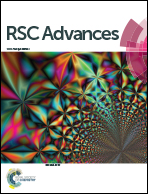Amine-functionalized MIL-53(Al) with embedded ruthenium nanoparticles as a highly efficient catalyst for the hydrolytic dehydrogenation of ammonia borane†
Abstract
Well-dispersed ruthenium nanoparticles (Ru NPs) are immobilized within the pores of amine-functionalized MIL-53 via an in situ impregnation-reduction method. The resulting Ru/MIL-53(Al)-NH2 catalyst exhibits superior catalytic performance for the dehydrogenation of ammonia borane (AB) at ambient temperature relative to the Ru/MIL-53(Al) catalyst; it has a turnover frequency (TOF) of 287 mol H2 min−1 (mol Ru)−1 and an activation energy (Ea) of 30.5 kJ mol−1. The amine groups present in the MIL-53(Al)-NH2 framework facilitate the formation and stabilization of ultra-small Ru NPs by preventing their aggregation. Additionally, the Ru/MIL-53(Al)-NH2 catalyst exhibits satisfactory durability and reusability: 72.4% and 86.3% of the initial catalytic activity was maintained after the fifth successive cycle of the hydrolytic dehydrogenation of AB in the two respective tests.



 Please wait while we load your content...
Please wait while we load your content...